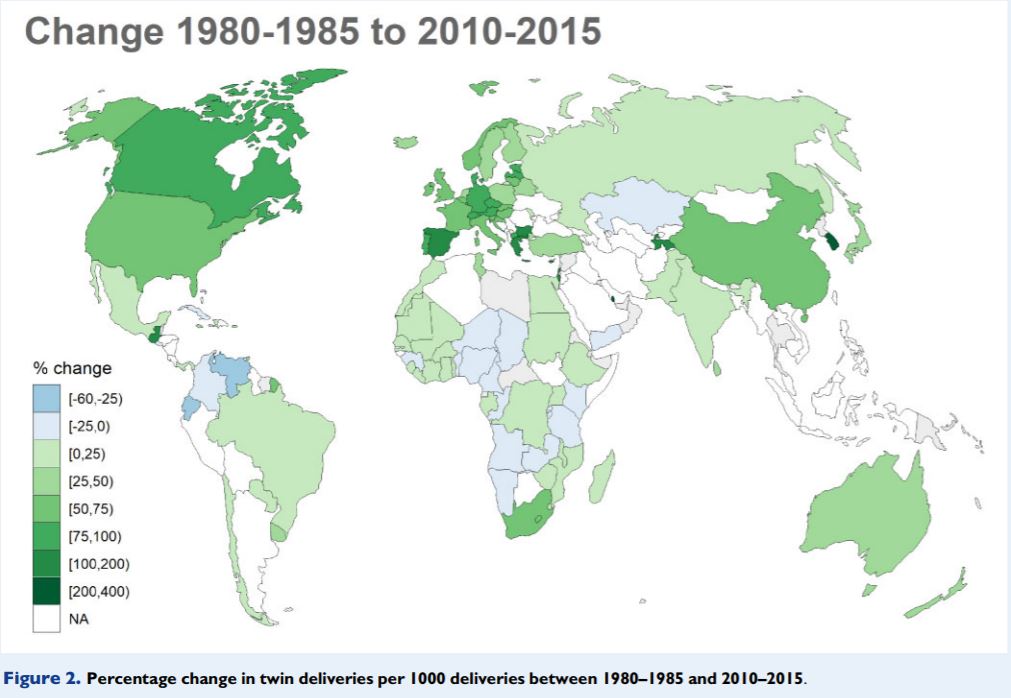More twins are being born than ever before
But we may have reached "peak twinning."

Twin births are multiplying, a new study finds. Worldwide, more twins are being born now than ever before.
Since the 1980s, the rate of twin births worldwide has increased by more than 30%, from 9 twin births per 1,000 deliveries in 1980-1985, to 12 twin births per 1,000 deliveries in 2010-2015.
What's more, the absolute number of twin deliveries increased by 42% during this period — from 1.1 million twin deliveries in the early 1980s to 1.6 million deliveries in the early 2010s. For comparison, the total number of births worldwide increased by only 8% during the same period.
Medically-assisted reproduction, which includes in vitro fertilization (IVF), or when an egg is fertilized with sperm in a lab dish and transferred to the uterus, may largely explain this rise, the authors said. IVF increases the chance of twins if more than one embryo is transferred.
However, some regions of the world may have reached "peak twinning" as fertility specialists reduce the number of embryos transferred with IVF.
"The relative and absolute numbers of twins in the world are higher than they have ever been since the mid-twentieth century, and this is likely to be an all-time high," study co-author Christiaan Monden, a professor of sociology at the University of Oxford in the United Kingdom, said in a statement. "This is important as twin deliveries are associated with higher death rates among babies and children and more complications for mothers and children during pregnancy, and during and after delivery."
More women are having children at a later age, which may also partly explain the rise of twin births, because older women are more likely to conceive twins, the authors said.
Sign up for the Live Science daily newsletter now
Get the world’s most fascinating discoveries delivered straight to your inbox.
Related: Seeing double: 8 fascinating facts about twins
More multiples
The study researchers analyzed information on twin births from 165 countries between 2010 and 2015. For 112 of these countries, the researchers also obtained information on twin births between 1980 and 1985, which allowed for a comparison between these periods.
The researchers found that over the three-decade period, the twin birth rate increased by more than 10% in 74 out of the 112 countries.
The increase is mainly due to increases in dizygotic, or fraternal, twins; rates of monozygotic, or identical, twins have remained about the same worldwide, with about 4 identical twin births per 1,000 deliveries.
On a continent level, North America saw the biggest rise in twin births, with a 71% increase in the rate of twin births over the three-decade period, followed by Europe, with a 58% rise, and Oceania, with a 46% rise.

Africa has the highest rates of twins worldwide, with about 17 twin births per 1,000 deliveries; but the rate remained mostly unchanged throughout the three-decade study period. It's thought that some populations in Africa may be more genetically prone to having twins, compared with populations in other parts of the world.
"In both periods, Africa had the highest twinning rates and there was no significant increase over time. However, Europe, North America and the Oceanic countries are catching up rapidly," Monden said.
But there is a large difference in the chances of survival for twins born in wealthy countries versus low-income countries.
"More attention needs to be paid to the fate of twins in low- and middle-income countries. In sub-Saharan Africa, in particular, many twins will lose their co-twin in their first year of life, some two to three hundred thousand each year," study co-author Jeroen Smits, a professor of comparative economic and human development at Radboud University in the Netherlands, said in the statement.
The researchers call for better tracking of twin births, particularly in lower income countries, as reliable data are lacking for many of those areas, which is the main limitation of the study.
Future studies are needed to determine if rates of twinning have indeed peaked in high income countries; and how increases in medically-assisted reproduction in low and middle income countries will affect the rates of twins in those areas.
The new study was published Thursday (March 11) in the journal Human Reproduction.
Originally published on Live Science.

Rachael is a Live Science contributor, and was a former channel editor and senior writer for Live Science between 2010 and 2022. She has a master's degree in journalism from New York University's Science, Health and Environmental Reporting Program. She also holds a B.S. in molecular biology and an M.S. in biology from the University of California, San Diego. Her work has appeared in Scienceline, The Washington Post and Scientific American.









